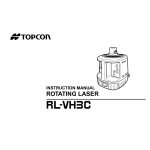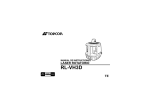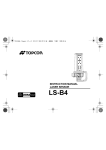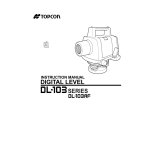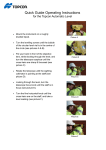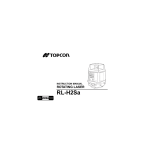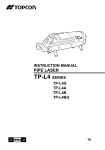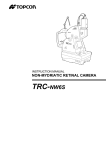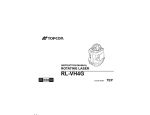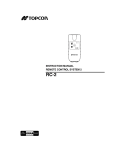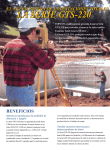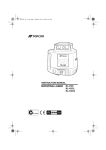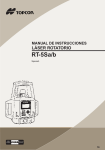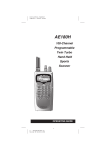Download INSTRUCTION MANUAL ROTATING LASER
Transcript
INSTRUCTION INSTRUCTION MANUAL MANUAL ROTATING LASER ROTATING LASER Declaration of Confomity R&TTE-Directive:99/5/EC WE: TOPCON EUROPE B.V. Esse Baan 11, 2908 LJ Capelle a/d IJssel, The Netherlands. declare on our own responsibility, that the product: Kind of Product: Rotating Laser Type Designation:RL-VH3C is in compliance with the following norm(s) or documents: I-ETS 300 220 / 10.1993 ETS 300 683 EN 60950 EU Foreword Thank you for purchasing the Topcon RL-VH3C Rotating Laser. It is one the world’s most advanced lasers. To quickly and effectively use the RL-VH3C, please read these brief instructions carefully; and keep them in a convenient location for future reference. Handling Precautions 1 Vibration and Impact Protection When transporting the instrument, provide protection to minimize risk of severe vibration or impact. Severe vibration or impacts may affect beam accuracy. 2. Laser Scanning Interference Particular reflective surfaces such as mirrors and some glass surfaces, can cause beam reflection that in very rare circumstances can interfere with the laser scanning function. If this should happen, simply change the location of the laser or cover the reflective surface. Caution: Use of adjustment controls or performance procedures other than those specified herein may results in hazardous radiation exposure. 1 Safety Information In order to encourage the safe use of products, to prevent damage to properties, and to prevent any danger to the operator and to others, important warnings are placed on the products and inserted in the instruction manuals. We suggest that everyone understand the meaning of the following displays and icons before reading the “Safety Cautions” and text. Display Meaning WARNING Ignoring or disregard of this display may lead to death or serious injury. CAUTION Ignoring or disregard of this display may lead to personal injury or physical damage to the instrument. Injury refers to hurt, burn, electric shock, etc. Physical damage refers to damage to equipment and structure or furnishings. 2 Safety Cautions WARNING • There is a risk of fire, electric shock or physical harm if you attempt to disassemble or repair the instrument yourself. This is to be carried out by TOPCON or an authorized dealer, only! • Laser beam can be dangerous, and can cause eye injury if used incorrectly. Never attempt to repair the instrument yourself. • Cause eye injury or blindness. Do not stare into beam. • Risk of fire or electric shock. Do not use a wet battery. • May ignite explosively. Never use an instrument near flammable gas or liquid matter, and do not use in a coal mine. • Battery can cause explosion or injury. Do not dispose in fire or heat. • The short circuit of a battery can cause a fire. Do not short circuit battery when storing it. 3 CAUTION Use of controls or adjustment or performance of procedures other than those specified herein may result in hazardous radiation exposure. Let the laser beam reach the aimed object or the target without anybody else in the laser beam path. When operating in an open area, avoid radiating laser beam at eye level. It is quite possible for the beam to enter into one's eyes, and it is possible to lose visual sight temporarily, and lose one's caution and awareness of other dangers - avoid glaring beam. Do not allow skin or clothing to come into contact with acid from the batteries, if this does occur then wash off with copious amounts of water and seek medical advice. Risk of injury by dropping the instrument or case. Do not use a carrying case with damaged belts, grips or latches. It could be dangerous if the instrument falls over, please check that you fix the instrument to the wallmount or tripod. Risk of injury by dropping a tripod and an instrument. Always check that the screws of tripod are tightened. Please note that the tips of tripod can be hazardous, be aware of this when setting up or carrying the tripod. 4 User Wear the required protectors (safety shoes, helmet, etc.) when operating. Exceptions from Responsibility 1) The user of this product is expected to follow all operating instructions and make periodic checks of the product’s performance. 2) The manufacturer, or its representatives, assumes no responsibility for results of a faulty or intentional usage or misuse including any direct, indirect, consequential damage, and loss of profits. 3) The manufacturer, or its representatives, assumes no responsibility for consequential damage, and loss of profits by any disaster, (an earthquake, a fire, an accident, storms, floods, an act of a third party and/or a usage other than under normal conditions.) 4) The manufacturer, or its representatives, assumes no responsibility for any damage, or loss of profits due to a change of data, loss of data, an interruption of business etc., caused by using the product or an unusable product. 5) The manufacturer, or its representatives, assumes no responsibility for any damage, or loss of profits caused by usage other than those usages explained in the user manual. 6) The manufacturer, or its representatives, assumes no responsibility for damage caused by wrong movement, or action due to connecting with other products. 5 Laser Safety This product projects a visible laser beam during operation. This product is manufactured and sold in accordance with “Performance Standards for Light-Emitting Products” (FDA/BRH 21 CFR 1040) or “Radiation Safety of Laser Products, Equipment Classification, Requirements and User’s Guide” (IEC Publication 825) provided on the safety standards for laser beam. As per the said standard, this product is classified as “Class 2 (II) Laser Products”. This is a simple product to operate and does not require training from a laser safety officer. In case of any failure, do not disassemble the instrument. Contact TOPCON or your TOPCON dealer. Labels Beam aperture Beam aperture AVOID EXPOSURE LASER LIGHT IS EMITTED FROM THIS APERTURE CAUTION LASER RADIATION-DO NOT STARE INTO BEAM WAVE LENGTH 635nm 1mW MAXIMUM OUTPUT CLASS II LASER PRODUCT LASER RADIATION DO NOT STARE INTO BEAM Maximum output 1mW Wave length 635nm CLASS 2 LASER PRODUCT The labels on your unit may be slightly different from the samples shown due to specific local requirements. 6 Contents Foreword ............................................. 1 Handling Precautions ....................... 1 Safety Information ............................. 2 Safety Cautions ................................ 3 User .................................................. 5 Exceptions from Responsibility ......... 5 Laser Safety ...................................... 6 Contents ........................................... 7 Standard System Components ......... 8 Nomenclature and Functions ............ 9 Preparation For Use ........................... 11 Battery Installation ............................ 11 Instrument Set-up Procedure ........... 11 Horizontal Rotation ........................... 11 Vertical Rotation ............................... 12 Battery warning lamp ........................ 12 Auto-leveling lamp ............................ 12 To turn the automatic leveling off ...... 12 Operation ............................................. 13 Scanning Mode ................................. 13 Laser Sensor Mode .......................... 14 Laser Pointing Mode (stop) ............... 14 Changing rotation speed (only available in laser pointing mode)14 Height Alert function ......................... 15 Setting Slopes ...................................16 How to set slopes ..............................17 To cancel slope settings ....................17 Setting slope in Y axis .......................17 Line Control (manual vertical beam alignment) ......18 Maintaining Power Sources ...............19 How to replace dry batteries .............19 Checking and Adjusting .....................20 Horizontal Calibration ........................21 Horizontal Rotation Cone Error ..........24 Vertical Calibration ............................25 Storage Precautions ...........................28 Standard / Optional Accessories .......29 Specifications ......................................37 7 Standard System Components 1 2 3 4 5 6 7 RL-VH3C Instrument............................................................................. 1pc. Magnetic Target .................................................................................... 1pc. Wall Mount (Model 1C).......................................................................... 1pc. D-size dry cells ..................................................................................... 4pcs. Carrying case ....................................................................................... 1pc. Calibration decals.................................................................................. 1set Instruction manual................................................................................. 1vol. Please make sure that all of the above items are in the box when you unpack. Additional Magnetic Scanning Targets may be included in some markets. Remote Control Option There are two RL-VH3C models, standard and remote control compatible. Standard models cannot be operated using the optional RC-30 remote controller (see page 36). Remote control compatible models are designated by the letter "R" following the model name on the serial number tag as shown below. RL-VH3C 8 RL-VH3C R ######## ######## Standard model Remote control compatible Nomenclature and Functions RL-VH3C Magnetic Scanning Target Laser emitting window Rotary head Magnet Beam aperture Datum line Index Handle Index Reflectors Wall Mount 1C Panel Clamp lever Leveling screw Battery holder Battery compartment lock Laser Mounting screw Elevation clamp knob 9 Control Panel Low battery alert Leveling lamp Circular level for vertical operation Flashing: Laser is leveling On: Auto-leveling is completed (RL-VH3C remote control model has standby mode) Power switch Mode switch control Alignment control Laser mode is switched alternately as follows. Scan mode Head rotates slowly, searching for Magnetic Scanning Target. When target is placed in beam path, laser rapidly scans back and forth on target. X/Y axis lamp X/Y axis selection key Select X or Y axis for manual beam sloping. Manual mode lamp ON: Manual leveling mode OFF: Auto-leveling mode Auto/manual leveling control ON/OFF of Auto-leveling. To turn off the auto-leveling, press this key twice. To turn on the auto-leveling again, press this key once. 10 Speed control With 'Laser Pointing Mode' selected, the rotation speed of the head can be changed. Laser sensor mode Laser sensor mode Head rotates at 300 rpm. Use this setting when using an optional electronic laser sensor such as the Topcon LS-70. Laser pointing mode Head stops rotating and the beam can be positioned by manually turning the head. Preparation For Use Battery Installation For battery placement or replacement instructions, see Maintaining Power Sources section, page 19. Instrument Set-up Procedure Horizontal Rotation 1 Set the instrument on any smooth surface that is within ±5° of true level. The RL-VH3C auto-level system will not function if the unit is placed more that 5° out of level. For best operation, it is recommended that it be mounted to a tripod or the Topcon Wall Mount Model 1C (provided). Slope can be set in both axes, X and Y. See "Setting Slope" section, page 16. Horizontal Leveling range 11 Vertical Rotation 1 Place the instrument on its back as shown in the illustration. 2 Turn the leveling screw on the instrument until the bubble is centered in the circular level vial. Battery Warning Lamp Flashing : The power is low ON Solid: Dead batteries Replace the batteries with new ones. Auto-leveling lamp Flashing : Auto-leveling is in process. When automatic leveling is almost complete, the flashing rate will be slow. The head will not rotate and the laser beam will not emit during the auto-leveling process. ON Solid: Auto-leveling is complete. The rotary head is active and emits the laser beam. To turn automatic leveling off To turn OFF the auto-leveling function (manual mode), press the Auto-Manual control pad twice in quick succession. The manual mode indicator light will illuminate. The instrument can be positioned in any direction, the laser beam remains on and the head will rotate. IMPORTANT: In manual mode, the laser beam will not shut off if disturbed! To return to Autoleveling mode, press Auto/Manual control pad once. 12 Operation Scanning Mode In scan mode, the laser rotates slowly, "searching" for the Magnetic Scanning Target. When the target is properly placed in the beam path, the laser beam will scan rapidly back and forth on the target and "track" the target as it is moved in its path. 1 To change to scanning mode when operating, press the Mode Control Pad. 2 To initiate target scanning, place the Magnetic Scanning Target in the beam path with the reflective strips facing toward the laser. Vertical rotation Horizontal rotation Set scanning mode Face the target toward the instrument to start scanning. 3 To end target scanning and resume searching beam, remove target from beam path. 13 Laser Sensor Mode For long range or outdoor applications, the instrument can be used with an optional electronic laser sensor. The Topcon models LS-70B or LS-70A are recommended. Press the Mode Control Pad to select Laser Sensor Mode. The beam rotates at 300 rpm in this setting. Laser Pointing Mode (stop) This mode stops rotation and allows the laser beam to be pointed by manually rotating the head. Press the mode control pad to select Laser Pointing Mode. Beam rotation stops in this mode. Changing rotation speed (only available in Laser Pointing Mode) After selecting Laser Pointing mode, press either Speed Control pad to change rotation speed. The right pad increases the rotation speed. The left pad reduces the rotation speed. 14 Laser pointing Height Alert function When auto-leveling is active, this function prevents the instrument from operating if it is disturbed. This serves as a reminder to the user that to insure accurate control, the height of the beam should be re-checked after the unit has been disturbed. 1 To activate the Height Alert function, depress and hold the left Alignment control pad (see page 10) on the control panel while turning on the instrument by pressing the Power control pad. The three LEDs (Leveling, Manual, Battery) will flash at the same time Leveling LED Battery LED for three seconds. Manual LED 2 When this function is active and the unit is disturbed, three visible LEDs will rapidly flash. 3 To re-activate auto-leveling and check the beam height, turn the unit off, then on again by pressing the Power control pad twice. After auto-leveling is complete, check the beam height to confirm it has not changed. 4 The Height Alert function is now inactive. To re-activate, turn unit off and repeat step 1. 15 Setting Slopes The laser beam can be manually sloped in either the X or Y axis (single slope) or both axes (compound slope).Using the Slope Control pads (see page 10), Inclination of the instrument the beam can be electronically raised or lowered 5 degrees above or below the inclination of the instrument. This means that slopes up to 5 degrees can Horizontal be obtained if the instrument is set up on a level surface. For slopes greater than 5 degrees, the instrument must be manually positioned to within 5 degrees of the slope desired. X axis Y axis Compound slope Single Axis 16 Dual Axes How to set slopes 1 Turn the instrument on by pressing the Power control pad. Auto-leveling will start. 2 Press the X/Y Axis Selection control pad once after auto-leveling is complete (see page 10). The X axis lamp will flash. To change to Y axis, press the X/Y pad once again. Pressing the X/Y pad toggles between X and Y axis selection. 3 Select Laser Pointing mode to stop beam rotation and manually align the beam over the X axis (see illustration on previous page). 4 To move the laser beam up or down, press and hold the right or left Alignment Control pad. The Manual mode lamp will illuminate. The flashing X axis lamp will change to solid after several seconds indicating slope has been entered in the X axis. 5 To set a compound slope, repeat steps 2 to 4 for the Y axis. To cancel slope settings Press the Manual Mode pad. The instrument returns to autoleveling mode. Sample; Laser pointing mode Move the beam up or down by pressing the right or left alignment keys Setting slope in Y axis Raise or lower the laser beam by pressing the right or left Alignment Control pad. 17 Line Control (manual vertical beam alignment) 1 Position the instrument for vertical operation as instructed on page 12. 2 Press the Power Control pad to turn unit on. When auto-leveling is complete, the laser beam will be emitted. 3 Select the Laser Pointing operating mode and using the laser beam, position the unit so the beam aperture is directly over point A and is roughly in line with point B (see illustration). 4 Rotate the head so the beam is pointing toward point B. Press either one of the Alignment Control pads to move the beam right or left until it is precisely aligned to point B. 5 Select the operating mode using the Mode Control pad best suited for your application. Note 18 • While an alignment control pad is pressed the auto-leveling beam shut-off will not operate. • To aid in beam alignment, Vertical Alignment targets are available from Topcon. Maintaining Power Sources How to replace dry batteries 1 Remove the battery cover by turning the battery compartment lock to “OPEN”. 2 Remove the old batteries and replace with four (4) new “D” cell alkaline batteries making sure each is placed in the proper direction as indicated. 3 Replace the battery cover and turn the knob to “Lock”. Note • Replace all 4 batteries with new ones. • Do not mix old batteries and new ones. 19 Checking and Adjusting There are three areas of performance the user should check periodically. Horizontal Calibration Horizontal Rotation Cone Vertical Calibration The Horizontal Calibration and Vertical Calibration can be easily checked and, in most cases, adjustments can be made by the user. Horizontal Rotation Cone can be checked by the user, if an error is found, adjustments must be made by a Topcon service facility. Attaching the calibration decals Before calibration, attach the calibration decals to the instrument as shown below. The calibration decal shows the calibration function of certain control pads on the control panel. Calibration Decals Y 3 1 START X CALIBRATION 1 2 X /Y 3 V 2 20 X Y V 4 ENTER ERROR 4 START-While pressing ,press ON XCAL-ON,YCAL-press VCAL-ON LASER BEAM CORRECTION - or ENTER-press X /Y CA 1 4 LIB RA STA 2 TIO XCAL RTN VCAL -ON While 3 LAS -ON ,YCAL- presing pres ER s BEA ,pre ENT or ss M COR ON ERpres RCT s ION X/Y Horizontal Calibration (1)Checking Calibration Instrument as seen from above 30m (98feet) Target Wall 1 Set up a tripod 30m(98ft) from a wall. Mount the instrument on the tripod, facing the X1 toward the wall. 2 3 Turn the unit on and allow auto-leveling to complete. 4 Loosen the tripod screw, rotate the instrument 180 Panel side Place a piece of paper on the wall. Detect a laser position on the wall with target and mark it. Turn the instrument off. degrees. Note • When rotating the instrument, avoid knocking it off level. 21 5 Turn the unit on again and allow auto-leveling to complete. 6 Make a new mark (Mb) where the laser beam strikes the paper. 7 Measure the distance between the first mark (Ma) and the second mark (Mb). No calibration is neces- If less than 6mm(.23 inches) No calibration Necessary X1 laser beam X2 laser beam sary if distance is within 6mm (.23 inches). 8 Repeat procedure for the Y axis. 30m (98feet) (2) Adjusting Calibration If the distance between either set of marks is more than 6mm (.23 inches) but less than 25mm (1 inch), turn the unit off by pressing the [START] pad once and using the following procedure. Confirm that unit has shut off before beginning the procedure. (In steps 2 and 3, use of optional RC-30 remote control can be helpful. See page 34.) 22 1 While pressing the [ENTER] key, press the [START] key. This activates the X axis calibration mode. Confirm that the [X] LED is lit. 3 1 START Center position Laser beam up or down X/Y 2 X Y V 4 ENTER ERROR 2 By pressing the right or left Alignment Control pad, move the X2 (Mb) laser beam up or down until its centered between marks Ma and Mb. 3 4 When the beam is precisely centered, press the [ENTER] key. The [X] LED will flash. When the flashing stops, the X axis calibration adjustment is made and power is turned off. • If the calibration is greater than the adjustment allows, the error LED will Note start flashing. If this occurs, contact your Topcon dealer. For Y axis calibration, turn the unit as instructed in step 1 above then press the X/Y Axis Selection pad. Confirm that the [Y] LED is lit, then repeat steps 2 to 4 for the Y axis. Repeat the checking procedure to confirm proper calibration has been made. 23 Horizontal Rotation Cone Error Perform the following check after completing "Horizontal Calibration" on the previous page. Minimum about 30m/98ft Cone error Wall A 1 2 3 4 5 6 Datum position Wall B Wall A Wall B Set up the laser centered between two walls approximately 30m (98 ft) apart. Orient the instrument so one axis, either X or Y, is facing the walls. Locate and mark the position of the rotating laser beam on both walls using the target. Turn off the instrument and move the instrument closer to wall A (1m to 2m /3 ft to 6 ft). Do not change the axis orientation of the instrument. Turn the instrument on. Again locate and mark the position of the rotating laser beam on both walls using the target. Measure the distance between the first and second marks on each wall. If the difference between each set of marks is less than 3mm (1/8 of an inch), no error exists. Note 24 • If the error is grater than 3mm (1/8 of an inch), contact your Topcon dealer. Vertical Calibration Perform the following check after completing "Horizontal Calibration" on the previous page. (1)Checking 1 2 3 4 5 6 about 20 m about 20 m (66ft) (66ft) Set up the instrument half way between 2 walls a minimum of 40m away from each Wall other. (The instrument can be facing A either direction X or Y. And no tripod is used.) Turn the power switch on. Place a piece of paper on each wall (A and B). Mark the horizontal laser positions (Ma and Mb) on each wall using target. Turn the power switch off. Position the about 40 m (130ft) instrument for vertical operation (see instruction on page 12) with the rotary Wall side directly facing wall A (see illustration). Make sure the unit is level by check- A ing the circular level vial. Use the leveling screw to adjust if necessary. Turn the power switch on. (Laser beam about 1m should be in scanning mode.) Mark where the split beam emitted from the top of the rotary head strikes wall A (Ha). Measure the distance (dHa) between marks Ma and Ha. Wall B Wall B Foot 25 7. Without moving the position of the front foot, pivot the instrument so the rotary head is 8 9 26 now facing wall B. Mark where the split beam emitted from the top of the rotary head strikes wall B (Hb). Measure the distance (dHb) between marks Mb and Hb. Compare the two measurements dHa and dHb. If the difference between the two measurements is less than 4mm (5/32 of an inch), no adjustment is necessary. Otherwise, adjust as follows. about 1m (2)Adjusting Calibration Turn the unit off by pressing the [START] pad once. Confirm that unit has shut off before beginning the following procedure.(In step 2 and 3, optional RC-30 remote control is helpful.) 1 Without moving the unit, press the [ENTER] and [START] keys simultaneously. 2 Press either the right or left key on the Alignment Control pad to move the laser beam up or down on wall B until the measurement for the distance dHb is the same as the measurement dHa on wall A. 3 Laser beam up or down 1 START 4 ENTER ERROR X/Y 2 X Y V 3 When the beam is positioned so the two measurements are the same, press the [ENTER] key. The [V] LED will flash. 4 When the flashing stops, the vertical calibration adjustment is made and power is turned off. • If the calibration is greater than the adjustment allows, the error LED will Note start flashing. If this occurs, contact your Topcon dealer. Repeat the checking procedure to confirm proper calibration has been made. 27 Storage Precautions Always clean the instrument after use. Use a clean cloth, moistened with a neutral detergent or water. Never use an abrasive cleaner, ether, thinner benzene, or other solvents. Always make sure instrument is completely dry before storing. Dry any moisture with a soft, clean cloth. 28 Standard / Optional Accessories Laser sensor holder model 5 160 159 158 157 156 155 154 153 152 151 Clamp knob 150 131 139 138 Laser sensor holder model 5 137 136 135 134 133 132 131 Laser sensor 130 129 128 127 126 125 Holder Model 5 allows the laser sensor to be moved up or down on the staff by squeezing the spring-loaded clamp on its back side without removing the sensor from the staff. 29 LS-70A Laser Sensor LS-70B Laser Sensor Beam receiving window Beam receiving window Display Display On-grade Index Audible (beeper) Indicator switch (Quite/Loud/OFF) On-grade Index On-grade Index On-grade precision switch Two on-grade precision options are available, normal precision and high precision. By pressing this switch, the precision options are switched alternately. Active precision setting is shown on the display. (Normal precision is the default setting when power is turned on.) Power switch Audio speaker Display backlight Power switch Audio speaker Audio indicator switch (Quite/Loud/OFF) Auto-cut off function (LS-70A and LS-70B) The power will be turned off automatically if no laser beam is detected within approximately 30 minutes. (To turn the sensor on again, press the power switch.) 30 Battery holder DB-49C Rechargeable battery pack BT-49Q AC/DC converter AD-9B/7C For Charging 1 Plug the AC/DC converter ( AD-7C) into the DB-49C battery holder. 2 Insert the converter receptacle in an outlet (AD-7C is for AC230V) 3 Complete charging by unplugging the converter connector from the DB-49C battery holder after approximately 9 hours. 4 Unplug the converter receptacle from the outlet. DB-49C AC/DC converter AD-7C BT-49Q DB-49C The LED of DB-49C will indicate charging status; Red ON : Charging. Green ON : Charging completed. Green flashing : DB-49C is not connected to BT-49Q. Red flashing : BT-49Q protection feature is working automatically. RL-VH3C can be used in this state. Automatic protection feature; In case of overcharge or high or low temperature state exceeding charging range, charging will be stopped or changed to protect battery. Note • DB-49C can be used with dry batteries instead of BT-49Q. 31 Wall mount model-2C Wall mount hole Floor mount model-6B Wall mount/dismount lever (Only for when using wall mount) Clamp handle Mount position control line LOCK UNLOCK Screw for tripod W5/8 Height adjustable mounting platform Leveling screw Wall mount hole Floor Mount Model 6B must be installed on instrument in order to use Wall Mount Model 2C. 32 This is used to attach the instrument to wall molding or metal studs. Grip wall angle/molding or screw to studs and tighten the attachment screw securely. Wall mount model-2C Mount position control line Denotes elevation of closed clamp Floor mount model-6B Wall mount hole Clamp handle LOCK UNLOCK Height adjustable mounting platform Scale Denotes beam height above or below mount position control line as mounting platform is moved up or down. Adjustment range Adjust screw Adjusting the inclination of wall mount unit. Use the left side scale for RL-VH3C. Fine movement knob Provides fine height adjustment Up Down Wall mount hole 33 RC-30 Remote Control (for remote compatible units only, see page 8) Transmission lamp Battery warning lamp for RC-30 Stop beam control (RL-VH3G/A/B only) Laser Power Switch (Standby mode) Pressing this switch for more than three seconds puts laser in standby mode, allowing the user to conserve battery power. If laser remains in standby mode for 2 hours, laser will turn off automatically. Mode switch control Speed control Manual focus control (RL-VH3G/A models only) Alignment control Slope mode / X/Y axis selection X/Y axis lamp 34 Press this key for more than three seconds to set slope mode or select X or Y axis. Description of RC-30 functions Laser power Pressing for more than three seconds turns laser standby mode on or off. Laser turns off switch if standby mode continues for two hours. (Standby mode) Transmission This lamp will indicates a signal is being transmitted by the RC-30. It should illuminate any time a control pad is pressed. lamp Battery warning Battery warning for RC-30. Replace the batteries with new ones. lamp for RC-30 Stop beam control Sets Stop Beam mode and moves laser. (RL-VH3G/A/B models only) Speed control The rotation speed of the rotary head can be changed. Alignment control Moves beam up or down (horizontal rotation). Moves beam right or left (vertical rotation). Indicates axis selected during beam sloping operation. Laser Power Turns laser standby mode on or off by pressing this key for more than three seconds. switch (The RL-VH3C will be turned off automatically if the standby mode is (Standby mode) continued for 2 hours) Mode switch Laser mode is switched alternately as follows. Scan mode / Laser sensor mode / Laser pointing mode. control Manual focus Laser beam can be focused manually. (RL-VH3G/A models only) control X/Y axis selection Sets slope mode by pressing for more than three seconds. Select X or Y axis for manual grading. To cancel the slope mode press this key for more than three seconds. X/Y axis lamp 35 How to set remote control communication channel The same channel must be set on the RL-VH3C and the RC-30 remote controller. RL-VH3C 1 Remove the battery cover by turning the battery compartment lock to “OPEN”. 2 Turn the channel switch to set a channel by using with a small straight screwdriver. 3 Replace the battery cover and turn the knob to “Lock”. Channel switch RL-VH3C Channel switch RC-30 Turn the channel switch to the same channel position set on the RL-VH3C. 3 Replace the rubber cover. 901 78 2 456 Remove the rubber cover from the channel switch on the back of the RC-30. 23 1 RC-30 36 Specifications Accuracy Horizontal : ±20" Vertical : ±20" Auto-leveling range : ±5° Measuring range (Diameter) : 60m(197ft) Diameter of visible beam : 4.5mm Rotation speeds : Changeable Light source : L.D (Visible laser) Power supply : 4D-CELL dry batteries Continuous operating time : Approx. 40 hours (+20°C) Tripod screw : Flat and dome head type, 5”/8 × 11threads Operating temperature : -20°C to +50°C (-4°F to +122°F) Dimensions : 182(L) × 167(W) × 229(H) mm [7.2(L) × 6.6(W) × 9.2(H) in] Weight : 1.9 kg [4.2 lbs] (without dry batteries) 2.5 kg [5.5 lbs] (with dry batteries) Remote controller RC-30 (Option for remote compatible units only, see page 8) Operating range Power supply : : Maximum 100m (328 ft) Three "AA" alkaline batteries, DC4.5V Using with LS-70A/70B : 200m(656ft) 37 38 TOPCON CORPORATION 75-1 Hasunuma-cho,Itabashi-ku,Tokyo,174-8580 Japan Phone:3-3558-2520 Fax:3-3960-4214 TOPCON AMERICA CORPORATION CORPORATE OFFICE 37 West Century Road, Paramus, New Jersey 07652, U.S.A. Phone: 201-261-9450 Fax: 201-387-2710 www.Topcon.com TOPCON CALIFORNIA 3380 Industrial BLVD, Suite 105, West Sacramento, CA 95691, U.S.A. Phone: 916-374-8575 Fax: 916-374-8329 TOPCON MIDWEST 891 Busse Road, Elk Grove Village, IL 60007, U.S.A. Phone: 847-734-1700 Fax: 847-734-1712 TOPCON LASER SYSTEMS, INC. 5758 West Las Positas Blvd., Pleasanton, CA 94588, U.S.A. Phone: 925-460-1300 Fax: 925-460-1315 www.topconlaser.com TOPCON EUROPE B.V. Esse Baan 11, 2908 LJ Capelle a/d IJssel, The Netherlands. Phone: 010-4585077 Fax: 010-4585045 www.topconeurope.com TOPCON BELGIUM Preenakker 8, 1785 Merchtem, Belgium Phone: 052-37.45.48 Fax: 052-37.45.79 TOPCON DEUTSCHLAND G.m.b.H. Halskestr. 7, 47877 Willich, Germany. Phone: 02154-9290 Fax: 02154-929-111 Telex: 8531981 TOPC D TOPCON S.A.R.L. 89, rue de Paris 92585 Clichy, Cedex France. Phone: 01-4106 9494 (MEDICAL) 1-4106 9490 (TOPOGRAPHIE) Fax: 01-47390251 http:// www.topcon.co.jp TOPCON (GREAT BRITAIN) LTD. HEAD OFFICE Topcon House Kennet Side, Bone Lane Newbury Berkshire RG14 5PX U.K. Phone: 001-44-1635-551120 Fax: 001-44-1635-551170 TOPCON SINGAPORE PTE. LTD. Alexandra Distripark Block 4, #05-15, Pasir Panjang Road, Singapore 118491 Phone: 2780222 Fax: 2733540 E-mail: [email protected] TOPCON AUSTRALIA PTY. LTD. 408 Victoria Road, Gladesville, NSW 2111, Australia Phone: 02-9817-4666 Fax: 02-9817-4654 TOPCON INSTRUMENTS (THAILAND) CO., LTD. 77/162 Sinn Sathorn Tower, 37th Fl., Krungdhonburi Rd., Klonglonsai, Klongsarn, Bangkok 10600 Thailand. Phone: 662-440-1152~7 Fax: 662-440-1158 TOPCON INSTRUMENTS (MALAYSIA) SDN. BHD. Lot 226 Jalan Negara 2, Pusat Bandar Taman Melawati, Taman Melawati, 53100, Kuala Lumpur, Malaysia. Phone: 03-4079801 Fax: 03-4079796 TOPCON KOREA CORPORATION Hyobong Bldg., 1-1306, Seocho-Dong, Seocho-Gu, Seoul, Korea. Phone: 02-3482-9231 Fax: 02-3481-1928 TOPCON OPTICAL (H.K.) LIMITED 2/F., Meeco Industrial Bldg., No. 53-55 Au Pui Wan Street, Fo Tan Road, Shatin, N.T., Hong Kong Phone: 2690-1328 Fax: 2690-2221 E-mail: [email protected] TOPCON CORPORATION BEIJING OFFICE Room No. 962 Poly Plaza Building, 14 Dongzhimen Nandajie, Dongcheng District, Beijing, 100027, China TOPCON ESPAÑA S.A. Phone: 10-6501-4191~2 Fax: 10-6501-4190 HEAD OFFICE TOPCON CORPORATION BEIRUT OFFICE Frederic Mompou 5, 08960, Sant Just Desvern Barcelona, Spain. P. O. BOX 70-1002 Antelias, BEIRUT-LEBANON. Phone: 93-473-4057 Fax: 93-473-3932 Phone: 961-4-523525/961-4-523526 Fax: 961-4-521119 MADRID OFFICE TOPCON CORPORATION DUBAI OFFICE Avenida Ciudad de Barcelona 81, 1 Planta 28007, Madrid, Spain. Offce No. 102,Khalaf Rashd AI Nayli Bldg., 245 Abu Hail Road, DeiPhone: 91-552-4160 Fax: 91-552-4161 ra,Dubai,UAE Phone: 031-261250 Fax: 031-268607 Telex: 21414 Phone: 971-4-696511 Fax: 971-4-695272 TOPCON SCANDINAVIA A. B. Industrivägen 4 P. O. Box 2140 43302 Sävedalen Sweden. Phone: 031-261250 Fax: 031-268607 Telex: 21414 RL-VH3C(R) (E) 31324 90140 0006(1a)









































